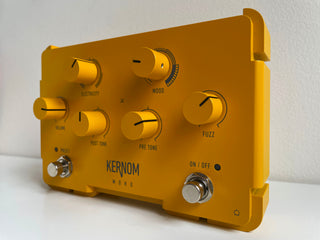A fuzz pedal can be a bit tricky to set correctly. Sometimes, no matter how you tweak it, you don’t find the right settings. Frustrating, isn’t it ? But, what if you could adjust how your pedal respond to your playing ? What if you could make it more bassy, or more trebly depending on your needs and what you plug in ? Take a look at the PRE TONE knob of the MOHO fuzz and the answer to these questions should be a big “hell yes” !
So, what is the PRE TONE ?
In today’s article, we'll talk about the PRE TONE knob of your MOHO fuzz pedal. It is a pretty convenient way to obtain your dream fuzz sound, or simply discover new tones.
Just like the RIDGE overdrive, the Kernom MOHO is an analog pedal. There is a strong similarity between the PRE TONE knobs of both pedals. The musician can adjust it to modify his sound and achieve the result he hears in his mind. From a technical point of view, the PRE TONE is an active EQ circuit placed before the gain stage. If you push it to the left, you can add a boost in the low frequencies up to 15dB. If you push it to the right, you will engage a high-pass filter that can go up to 1kHz. To make it simple, it will make your sound more bassy or more trebly depending on what you do. Essentially, that’s it.

If we go deeper in details, the PRE TONE changes the way the pedal responds to the musician’s playing. You can adjust the saturation level of each note with high gain, depending on its pitch. Thanks to this, you will have a more compressed sound or, on the contrary, have a better note separation.
An important thing to keep in mind is that the effect of the PRE TONE will also depend on where you set the MOOD knob. In the first zone of the MOOD, the fuzz circuit is under-biased, creating a strong gating effect. Adjusting the PRE TONE will change this gating behaves. Fuzz can be unpredictable and the MOHO fuzz pedal is no exception !
Hear the PRE TONE effects on your fuzz tone
The PRE TONE offers a wide range of sounds. Each one of them can be convenient according to what you play. It’s also interesting to adjust it if you have guitars with different pickups, for example. Whether you seek for an aggressive fuzz sound, or for a fat and rich fuzz tone, both are achievable ! To illustrate our article, we recorded some examples. We plugged our guitars into the MOHO fuzz, straight into our amp. Each of these examples starts with the PRE TONE in the center position, which is also its neutral position. The knob isn’t active when set like this. Then we turn it from the left to the right, so you can hear its effect.
As you’ve heard, the PRE TONE is highly effective. It is a good way to change the reaction of your analog fuzz pedal, without changing all the settings. But keep in mind : a fuzz pedal is a wild beast to tame ! It could take some time in order to find settings you love on your MOHO fuzz. ;)
Take control of your MOHO fuzz
Once again, I would like to mention the expression pedal. You can find here the basic informations : https://kernom.com/blogs/tips-tones/morph-your-sound-with-the-expression-pedal Being also a MIDI pedal, you can act on the MOHO’s PRE TONE with an expression pedal. This can be a new way of adjusting your tone. You could add more bass or more treble on the fly during a song, with a single foot movement. Of course, it’s just an idea and you can imagine other applications.
Try different settings with the PRE TONE of your MOHO fuzz
To conclude, the PRE TONE is a pivotal feature of the MOHO fuzz. It is a good mean to enhance your tone and fine tune the interaction between your instrument and the pedal. Again, take the time to find the right settings for YOU and YOUR sound.

by Anthony Barbier
Anthony is the person behind Kernom social media. If you’re searching for him, he will probably with a guitar in his hands, trying to find new sounds or behind his keyboard writing posts about our pedals.
